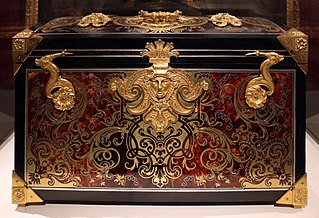
Furniture refers to objects intended to support various human activities such as seating, eating (tables), storing items, working, and sleeping. Furniture is also used to hold objects at a convenient height for work, or to store things. Furniture can be a product of design and can be considered a form of decorative art. In addition to furniture's functional role, it can serve a symbolic or religious purpose. It can be made from a vast multitude of materials, including metal, plastic, and wood. Furniture can be made using a variety of woodworking joints which often reflects the local culture.

Marquetry is the art and craft of applying pieces of veneer to a structure to form decorative patterns, designs. The technique may be applied to case furniture or even seat furniture, to decorative small objects with smooth, veneerable surfaces or to freestanding pictorial panels appreciated in their own right.

A settle is a wooden bench, usually with arms and a high back, long enough to accommodate three or four sitters.

A commode is any of many pieces of furniture. The Oxford English Dictionary has multiple meanings of "commode". The first relevant definition reads: "A piece of furniture with drawers and shelves; in the bedroom, a sort of elaborate chest of drawers ; in the drawing room, a large kind of chiffonier." The drawing room is itself a term for a formal reception room, and a chiffonier is, in this sense, a small sideboard dating from the early 19th century.

A sideboard, also called a buffet, is an item of furniture traditionally used in the dining room for serving food, for displaying serving dishes, and for storage. It usually consists of a set of cabinets, or cupboards, and one or more drawers, all topped by a wooden surface for conveniently holding food, serving dishes, or lighting devices. The words sideboard and buffet are somewhat interchangeable, but if the item has short legs, or a base that sits directly on the floor with no legs, it is more likely to be called a sideboard; if it has longer legs, it is more likely to be called a buffet.
Tallboy or tall boy may refer to:

A chest of drawers, also called a dresser or a bureau, is a type of cabinet that has multiple parallel, horizontal drawers generally stacked one above another.

Thomas Shearer was an 18th-century English furniture designer and cabinet-maker.

A lowboy is an American collectors term for one type of dressing table. It is a small table with one or two rows of drawers, so called in contradistinction to the tallboy or highboy chest of drawers.

A washstand or basin stand is a piece of furniture consisting of a small table or cabinet, usually supported on three or four legs, and most commonly made of mahogany, walnut, or rosewood, and made for holding a wash basin and water pitcher. The smaller varieties were used for rose-water ablutions, or for hair-powdering. The larger ones, which possessed receptacles for soap dishes, were the predecessors of the modern bathroom wash basin, or sink. Both varieties, often of very elegant form, were in extensive use throughout a large part of the 18th century and early-19th century, eventually disappearing with the advent of modern indoor plumbing.

Charles Cressent (1685–1768) was a French furniture-maker, sculptor and fondeur-ciseleur of the régence style. As the second son of François Cressent, sculpteur du roi, and grandson of Charles Cressent, a furniture-maker of Amiens, who also became a sculptor, he inherited tastes, skills and aptitudes which contributed to his success as an artist. Even more important, perhaps, was the fact that he was a pupil of André Charles Boulle. Cressent's distinction is closely connected with the regency, but his earlier work had affinities with the school of Boulle, while his later pieces were full of originality.
Campaign furniture is a type of furniture which is made for travel. Historically, much of it was made for military campaigns.

The term chiffonier, also chiffonnier, may refer to one of at least two types of furniture. Its name comes directly from a French piece of furniture, the chiffonier. The French name, which comes from the French for a rag-picker, suggests that it was originally intended as a receptacle for odds and ends which had no place elsewhere.
A wardrobe or armoire or almirah is a standing closet used for storing clothes. The earliest wardrobe was a chest, and it was not until some degree of luxury was attained in regal palaces and the castles of powerful nobles that separate accommodation was provided for the apparel of the great. The name of wardrobe was then given to a room in which the wall-space was filled with closets and lockers, the drawer being a comparatively modern invention. From these cupboards and lockers the modern wardrobe, with its hanging spaces, sliding shelves and drawers, evolved slowly.

A cabriole leg is one of (usually) four vertical supports of a piece of furniture shaped in two curves; the upper arc is convex, while lower is concave; the upper curve always bows outward, while the lower curve bows inward; with the axes of the two curves in the same plane. This design was used by the ancient Chinese and Greeks, but emerged in Europe in the very early 18th century, when it was incorporated into the more curvilinear styles produced in France, England and Holland.

A cellarette or cellaret is a small furniture cabinet, available in various sizes, shapes, and designs which is used to store bottles of alcoholic beverages such as wine or whiskey. They usually come with some type of security such as a lock to protect the contents. Such wooden containers for alcoholic beverages appeared in Europe as early as the fifteenth century. They first appeared in America in the early eighteenth century and were popular through the nineteenth century. They were usually made of a decorative wood and sometimes had special designs so as to conceal them from the casual observer. They were found in pubs, taverns, and homes of the wealthy.

A cabinet is a case or cupboard with shelves and/or drawers for storing or displaying items. Some cabinets are stand alone while others are built in to a wall or are attached to it like a medicine cabinet. Cabinets are typically made of wood, coated steel, or synthetic materials. Commercial grade cabinets usually have a melamine-particleboard substrate and are covered in a high pressure decorative laminate, commonly referred to as Wilsonart or Formica.

This high chest of drawers, also known as a highboy or tallboy, is part of the Decorative Arts collection of the Indianapolis Museum of Art in Indianapolis, Indiana. Made between 1760 and 1780 in Philadelphia, Pennsylvania, its design was inspired by British furniture-maker Thomas Chippendale.

What later came to be known as the William and Mary style is a furniture design common from 1700 to 1725 in the Netherlands, Kingdom of England, Kingdom of Scotland and Kingdom of Ireland, and later in England's American colonies. It was a transitional style between Mannerist furniture and Queen Anne furniture. Sturdy, emphasizing both straight lines and curves, and featuring elaborate carving and woodturning, the style was one of the first to imitate Asian design elements such as japanning.

















